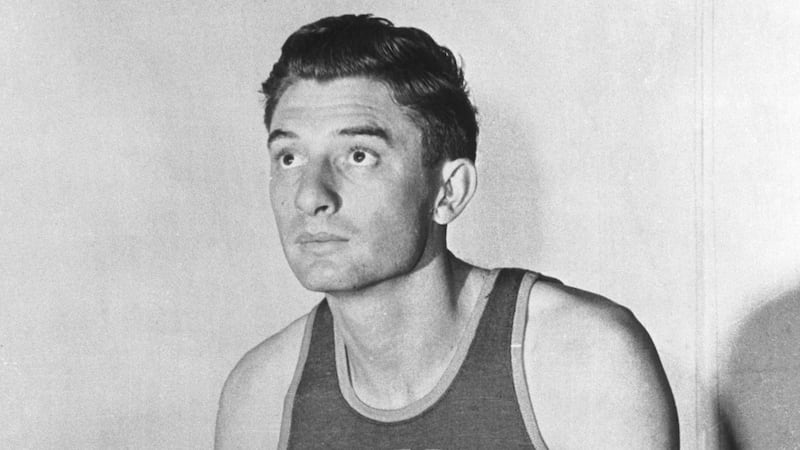Jumpin' Joe Fulks is buried in a nondescript grave at the Birmingham Cemetery in Briensburg, Kentucky. The headstone bears just his name and the years he lived, a tiny marker in the grass acknowledges his service in the United States Marine Corps during the Second World War.
There is no mention of the fact he was the NBA’s first superstar, the most prodigious scorer in its formative seasons and the player who, more than any other, popularised the jump shot, one of the defining features of the modern game. As a metaphor for the neglect of a sporting legend’s contribution to a sport, the obscurity of his final resting place is near enough perfect.
With typical fanfare and a smidgen of controversy, the NBA marked the beginning of its 75th season last week by naming the league's 75 best players ever, and, very briefly, Fulks flickered across the social media sphere. Hardcore devotees of the game's professional origins, the true anoraks, took umbrage at this pioneer's omission from the line-up while the rest of the hoops world concerned itself with the absences of Dwight Howard, Manu Ginobili and other contemporary causes du jour. Good cases might be made for the inclusion of many of those snubbed but only Fulks has been credited with ensuring the very survival of the fledgling competition itself in post-war America.
"If it hadn't been for Joe," said Paul Arizin, another Hall of Famer, "I don't think basketball would have made it those first few years."
Growing up in the maw of rural poverty in Kentucky during the Great Depression, he and his friends first played an improvised version of the game with an amalgam of balled-up rags, toilet paper and sawdust in lieu of an actual ball, and he practiced free throws on his own by tossing tin cans through the hoops of the local outdoor court.
When the former mining town where he lived was due to be flooded by the damming of the Tennessee River, the Fulks were forced to move on. They decamped to Kuttawa, for the simple reason that the basketball alickadoos there offered Joe’s father a job just so he could play for the high school team. Everybody in the region already knew he had something.

After subsequently lighting up the college scene with Murray State, he served with the marines in the South Pacific theatre, seeing action on Iwo Jima. Like many talented athletes in the service, his sporting gifts were called upon too and he played in a travelling all-star basketball team called "The Leathernecks" that entertained the troops at Pearl Harbour. There, his all-action shoot on sight policy garnered admirers, including Eddie Gottlieb who signed him for the Philadelphia Warriors ahead of the inaugural 1946/47 season of the Basketball Association of America (the league that soon became the NBA).
Earning $8,000 a year, at the age of 26, he scored 25 points on his pro debut and his 63 against the Indianapolis Jets was a single-game record that stood for a decade. Indeed, the great Red Auerbach once wondered if that tally might not be bettered for 90 years. Gaudy as his statistics undoubtedly were (first to score 1,000 points in a season), they only hint at how he transformed the sport. At a time when basketball was a conservative, low-scoring and more pedestrian affair, Fulks added pace, dynamism and excitement when, rather than stopping to set his feet before shooting, he went airborne to release the ball.
“They give me the ball and I shoot,” said Fulks. “That’s all there is to it.”
Purists often baulked at the number of shots he took and accused him of being selfish but crowds loved his approach. In Philly, they wrote a song and named a sandwich after him, and one newspaper ran a cartoon of Fulks throwing bricks into a cement mixer, the punchline being that his impact on the box office was funding construction of a new arena in the city.
For all that, there was one serious problem that caused his career to end perhaps sooner than it should have. Having developed a taste for alcohol imbibing the fabled moonshine distilled in the hollers of his native Kentucky, teammates swore there were plenty of games where they could smell drink on his breath even as he somehow drained shot after shot.
In retirement, he worked for two decades in a chemical factory before becoming a recreational aide at the Kentucky State Penitentiary, all while battling the bottle. After finishing a shift at the prison one afternoon in 1976, he made a booze run to nearby Paducah to purchase six half-pints of cheap Tvarscki vodka before fetching up at the trailer park in Eddyville where his then girlfriend Roberta Bannister lived. Not two miles from the high school basketball court where he first served notice of his talent to the world, he whiled away the evening, like so many others, in a fog of drink, arm-wrestling with her 22-year-old son Greg.
At some point in the early morning, the two men had a drunken argument about ownership of a pistol and Bannister shot Fulks dead with a 20-gauge shotgun. One obituary described the 54-year-old as “the jump shot innovator”, another reckoned he had once been “the Babe Ruth of basketball”. They still remembered the significance of his contribution to the sport then. Not so much now.













